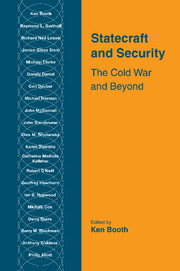Book contents
- Frontmatter
- Contents
- List of contributors
- Preface
- Introduction
- Part one Cold War: lessons and legacies
- 1 Cold Wars of the mind
- 2 Who is to blame for the Cold War?
- 3 Nuclear lessons of the Cold War
- 4 A Cold War life, and beyond
- Part two Post-Cold War: powers and policies
- Part three Beyond: resistances and reinventions
- Conclusion: security within global transformation?
- Index
3 - Nuclear lessons of the Cold War
Published online by Cambridge University Press: 06 October 2009
- Frontmatter
- Contents
- List of contributors
- Preface
- Introduction
- Part one Cold War: lessons and legacies
- 1 Cold Wars of the mind
- 2 Who is to blame for the Cold War?
- 3 Nuclear lessons of the Cold War
- 4 A Cold War life, and beyond
- Part two Post-Cold War: powers and policies
- Part three Beyond: resistances and reinventions
- Conclusion: security within global transformation?
- Index
Summary
The role of nuclear weapons in Soviet–US relations has been hotly debated. Politicians, generals and most academic strategists believe that the United States' nuclear arsenal restrained the Soviet Union throughout the Cold War. Critics maintain that nuclear weapons were a root cause of superpower conflict and a threat to peace. Controversy also surrounds the number and kinds of weapons necessary to deter, the political implications of the strategic balance, and the role of nuclear deterrence in hastening the collapse of the Soviet imperium.
Careful analysts were alert to the difficulty of making definitive judgements about deterrence in the absence of valid and reliable information about Soviet and Chinese objectives and calculations (MccGwire, 1985/6; Betta, 1987; Bundy, 1988). Newly declassified documents and extensive interviews with Soviet and US officials permit a reconstuction of the deliberations of leaders of both superpowers before, during and after the two most serious nuclear crises of the last thirty years: the Cuban missile crisis of 1962 and the superpower crisis arising out of the 1973 Middle East war. This evidence sheds new light on some of the controversies at the centre of the nuclear debate (Lebow and Stein, 1994). Needless to say, definitive judgements must await the opening of archives and more complete information about the calculations of Soviet and US leaders in other crises, as well as those of other nuclear powers.
Restraining, provocative or irrelevant?
Students of nuclear deterrence distinguish between general and immediate deterrence (Morgan, 1977).
- Type
- Chapter
- Information
- Statecraft and SecurityThe Cold War and Beyond, pp. 71 - 86Publisher: Cambridge University PressPrint publication year: 1998
- 1
- Cited by



